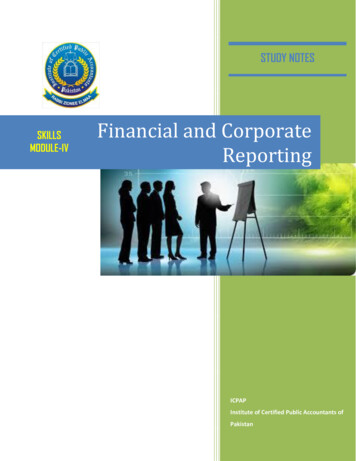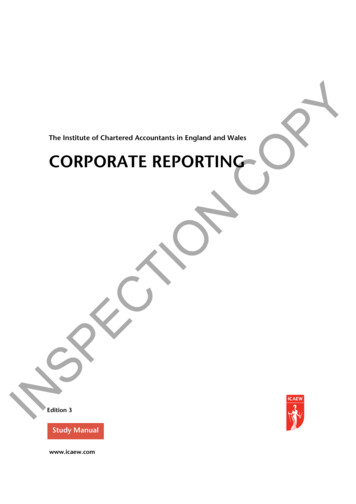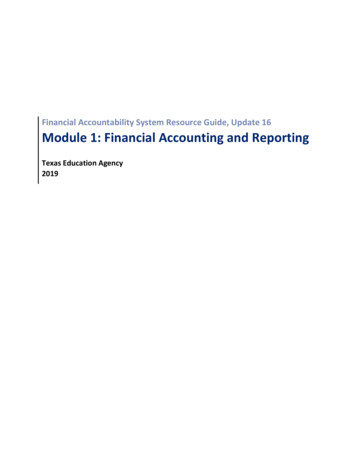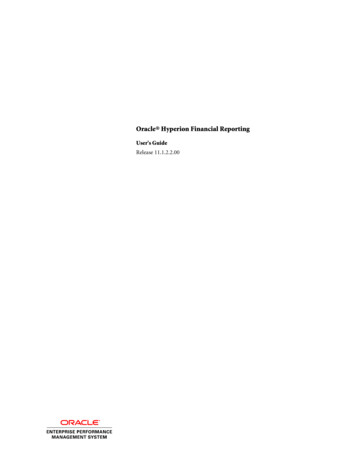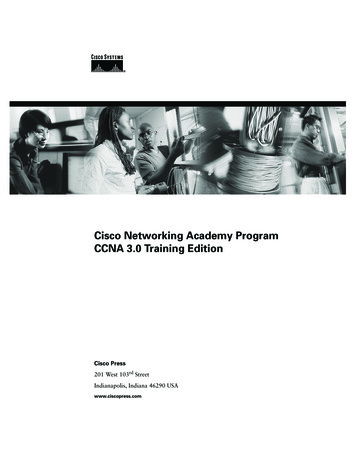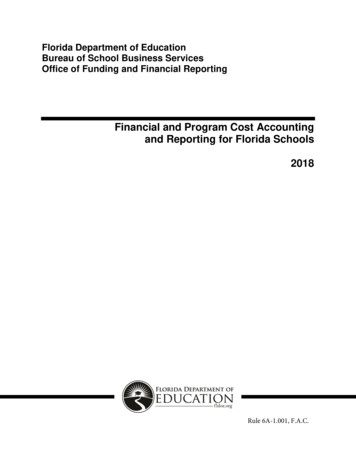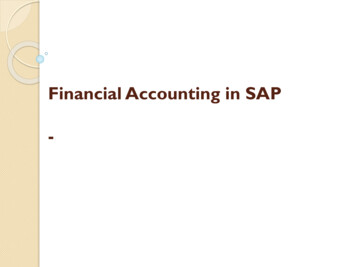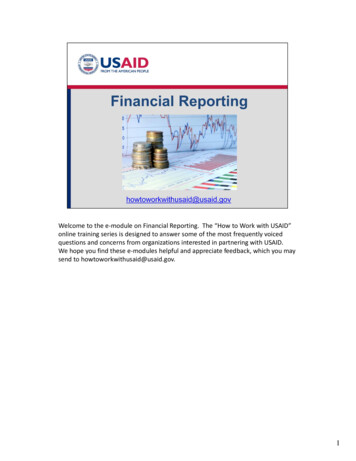
Transcription
Welcome to the e‐module on Financial Reporting. The “How to Work with USAID”online training series is designed to answer some of the most frequently voicedquestions and concerns from organizations interested in partnering with USAID.We hope you find these e‐modules helpful and appreciate feedback, which you maysend to howtoworkwithusaid@usaid.gov.1
The objective of this e‐module is to assist partners to understand the purpose,format, and timing of key financial reports.In this e‐module,1. First, we will go through the process of filling out the quarterly federal financialreport, the SF‐425.2. Second, we will describe how to request an advance or reimbursement.3. Thirdly, we will provide a brief overview of the Annual Foreign Tax Report.4. At the end, we’ll also provide some tips on how to prepare outstanding financialreports and avoid common problems.Which reports are required are covered in your award. So you should carefully readthese sections of your award, and at the post‐award orientation conference (orany time during the management of your award), you should ask the financialanalyst about what reports and formats are required.All awards contain both programmatic and financial requirements. In this module,we will only review the typical financial reports. For information on programmaticreporting, please see our e‐module on “Programmatic Reports.”2
First, let’s understand the Federal Financial Report, or SF‐425, which is acumulative report that captures the financial status of an agreement at aspecific point in time.3
The federal financial report, coupled with your budget, helps determinewhether the expenditures are aligned with the implementation of theproject. Submitted on a quarterly basis, the SF‐425 provides an opportunityto re‐assess assumptions made earlier in the budgeting and planningprocess. USAID staff use information from the SF‐425 to reconcile its records toensure accuracy in financial reporting and oversight. Analysis of thisinformation permits both USAID and the organization to identify how quicklyfunds are being used (known as the burn rate) and how much moneyremains for future use (known as the pipeline). From the partner side, accurately completing the SF‐425 demonstrates anorganization’s understanding of their financial management responsibilities.A firm understanding and execution of financial management responsibilitiesis necessary for a successful activity.4
The SF‐425 is available from the link shown here. A completed form shows:1. how much money has been drawn down against the award,2. what the money was used for, and3. what the balance of unused money is at the end of the reporting period. Supporting documents should be available if requested and sufficient toconfirm the allocation of funds to the agreement’s budget line items. Remember, a separate SF‐425 must be used for each USAID award. If anorganization has two USAID awards, they will submit two SF‐425s. In thenext slides, we will go step‐by‐step through completing a Federal FinancialReport. The following slides will explain how to complete each section of the SF‐425. You also can access an additional resource – the USAID SF‐425 FederalFinancial Report Process Guide – through this link.5
The top portion of the Federal Financial Report, or SF‐425, requires you to enterbasic information about your organization and award. In Box 1, enter USAID followed by the name of the Mission or Bureau from whichyou received the award. E.g. USAID Southern Africa. This information also isavailable in the award document. In Box 2, enter the USAID‐assigned award number found on the first page of youraward. Enter your organization’s address in Box 3. Box 4(a) asks for the organization’s Data Universal Numbering System, or DUNS,number. Every organization that receives an award from USAID must have a DUNSnumber. For more information about how to obtain a DUNS number or to makeupdates to your information, see our e‐module on DUNS. Box 4(b) is the Employer Identification Number (EIN) and only applies to U.S.organizations. Box 5 is for the “Recipient Account Number or Identifying Number.” You mayleave this blank, as it is not required by USAID but simply provides space toaccommodate organization‐specific tracking. Please do not enter bank accountinformation here. Box 6 is for the frequency of report you are submitting. This will be specified in theagreement. Most of the time you will check quarterly. The last report for the6
agreement (not individual projects/tasks) should be marked Final and is required within 90days of the agreement expiration. Box 7 identifies the accounting basis for your organization. Check with your accountant andcheck either cash or accrual. Box 8 indicates your award’s start and end date. And finally, Box 9, is for the end date of the reporting period. Since the SF‐425 is typicallydue quarterly, this date is likely December 31st, March 31st, June 30th, or September 30th.However, for the last report of the award, or the “final” report, the end date will be theactual end date of the award. Much of this information in the top portion will remain the same for each quarterly SF‐425that you submit.6
Let’s continue on to Section 10 of the SF‐425 which we’ll discuss over the nextthree slides. This section details your award’s transactions. The first section, A through C is used to track the federal cash received from theaward. Box 10(a), cash receipts, is the cumulative amount of cash received from thisUSAID award either through advances or reimbursements through the end date ofthe reporting period specified in line 9. 10(b), cash disbursements, is the total cash the organization has used in theimplementation of the project, including cash advances and payments made to sub‐recipients and contractors. 10(c) is a simple mathematical calculation to determine the organization’s cash onhand for this award. Simply subtract 10(b) from 10(a). Please note some agreements are not denominated in U.S. dollars. In this case,10(a) through 10(c) should be in the currency indicated in the award documents.7
Continuing with section 10, we’ll now look at your award’s federalexpenditures and unobligated balance. Line 10(d) is for the total amount of USAID funds obligated to the award.This amount is cumulative and should include the original obligation plus alladditional modifications (if any). This should not be confused for the TotalEstimated Cost. 10(e) is for the total funds expended. It should include any disbursementsor expenses directly billed to and paid by USAID. It will typically be equal tothe cash disbursements reported in 10(b). 10(f) represents unliquidated obligations, or expenses incurred but not yetpaid for or recorded, otherwise known as accruals. This contains alloutstanding amounts owed to contractors, sub‐recipients, or vendors but notyet invoiced to USAID. 10(g) is the total accrued expenditures, which is calculated by adding thevalues in line 10(e) and 10(f). 10(h) calculates the pipeline, which identifies all obligated funds remainingfor future use. It is calculated by subtracting 10(g) from 10(d). Unlike lines 10(a) through 10(c), the currency for lines 10(d) through 10(h)must be reported in U.S. dollars regardless of the currency indicated in the8
award documents.8
Lines 10(i) through 10(k) – “Recipient Share” represents the awardee organization’scost share. This section is only completed if cost sharing is required by theaward. Otherwise, these lines should be marked “N” slash “A” for notapplicable. Lines 10(l) through 10(o) – “Program Income” reports the cumulative incomegenerated by the project as a result of work performed under the award. Ifyour award allows for program income, please refer to the detailed instructions onthe OMB Line Item document included under the resources tab. If your awarddoes not allow for program income or no income has been generated, theselines should be marked “N/A”. Note that lines 10(i) through 10(o) must be denominated in the currency yourorganization uses in project implementation.9
Section 11 is completed only if charging an indirect cost rate is required by theaward. Otherwise, these lines should be marked “N/A”. Note that somecontractors have multiple rates. You should use the one applicable to thespecific award for which you’re reporting. If charging an indirect cost rate is required, the type of rate must be identified in11(a) such as “Provisional”, “Predetermined”, “Final” or “Fixed.” 11(b) is the indirect cost rate in effect during the reporting period. 11(c) is the beginning and ending dates for the rate. 11(d) is the base amount against which the rate is applied. For example, if theaward provides an indirect cost rate and was negotiated using salaries and wages,then application of the rate must be applied to a base that contains only salariesand wages. Finally, in 11(e), multiply 11(b) x 11(d) to calculate the amount of indirect costscharged during the time period specified. The Federal Share in 11(f) will equal the amount in 11(e), unless you arecharging the government less than the indirect costs incurred. Line 12 provides an opportunity to include explanations or narrative important tothe overall report. Examples may include an excess of cash on hand, pipelineanomalies, changes in the indirect cost rate, or clarification on prior reportadjustments or corrections.10
Once you have finished, double‐check to make sure all calculations are correct. Fillin the information of the authorized certifying official in Section 13, sign, scan, andsend the form to the person indicated in your award, copying your Contracting orAgreement Officer Representative (CAOR).10
Federal Financial Reports must be submitted in the frequency specified bythe award. Typically, USAID requires quarterly submission of the SF‐425. This Report is due to USAID no more than 30 days after the end of each of USAID’sfinancial quarter. USAID’s fiscal year begins October 1 and ends on September 30th.Therefore the typical deadlines for submission is the last day of January, April, July,and October, as shown in this chart. Delays in submitting a correct SF‐425 may interrupt program activities due topostponed funding and invites increased oversight by USAID staff and auditors.Sending a correct SF‐425 on time is considered indicative of a good financialmanagement system. Note that organizations are required to notify USAID once they have spent 75% ofthe award’s obligation.11
The U.S. Government disburses funds in two ways, either by advancing fundsor by reimbursing partners for expenses. The format required for makingrequests for advances or reimbursements is specified by your award and canbe further explained by your USAID’s financial management office in thecountry in which you work.12
USAID is subject to strict cash management regulations and policies.Advance and reimbursement requests facilitates compliance with theserequirements. These regulations and policies strengthen USAID’s ability toefficiently and effectively account for the use of funds. Accurate and timely cash management requires a robust internal controlsystem. Advance and reimbursement requests are reconciled with USAIDrecords to ensure accuracy in financial reporting and oversight. USAID monitor’s an organization’s cash management ability, which indicatesthe quality and strength of an organization’s internal control system.13
Awardees can submit advance or reimbursement requests on one of twoforms, the SF‐270 or the SF‐1034. Generally, USAID prefers organizations touse the SF‐1034. Please read your award and follow the instructionsprovided and discuss with your financial office which forms should be used. To ensure the continuity and success of the program, requests must becomplete, accurate, and timely. For organizations requesting areimbursement, the amount requested should reflect the exact amountspent over the period. For organizations submitting requests for an advance,the amount must be an estimate of “immediate needs” supported with acash‐flow budget. You should limit your requests to “immediate disbursing needs.” Immediateneeds typically means what the organization expects to spend in the comingmonth. This amount should include all funding anticipated for sub‐recipientorganizations during that period. Advance requests should reflect the actualcash‐flow needs for the period and not simply be the annual budget dividedby 12. Partners with sub‐recipients should work together to ensure fundingrequests and spending are managed smoothly. Ask sub‐recipients to providemonthly funding estimates. See ADS 636 on program funded advances formore information.14
This is what an SF‐1034 looks like. The complete form can be accessedunder the Resources tab in the top right corner of this e‐module. Onlythose portions indicated in red must be completed. As you can see, thedetails are relatively basic, which is why it is important to ensure the SF‐1034 is accompanied by the supporting cash‐flow budget as well as acertification. USAID tracks and reports funding by purpose and location. Anorganization can help expedite processing by itemizing funding andliquidation requests using programmatic and geographical information.For example, a health award may use funding for prevention programsrelated to HIV, TB, Malaria, and gender‐based violence – all of which maybe occurring in multiple countries, provinces, or cities. Please note thatthe SF‐1034 can each be adjusted to accommodate multiple lines. As previously mentioned, organizations are required to notify USAID oncethey have spent 75% of the award’s obligation.15
For advance requests, you also need to submit a supporting cash‐flowbudget. This is also referred to as a pipeline analysis or burn rate. This helpsUSAID ensure that there is enough money available to cover your upcomingexpenses and to make sure your project does not end up over budget. Pipeline funds are the funds that have been obligated to your project buthave yet to be spent. The burn rate is an estimate for how fast your award’s obligated funds arecurrently being spent and is used to estimate how long your remaining fundswill last. In the next two slides we’ll provide examples of how to do a pipelineanalysis and burn rate calculation to submit with advance requests.16
Here is a simplified example of a pipeline analysis, which is typically used as areference for incremental funding for the award. Column A shows the Total Estimated Cost (or TEC), either original or revised, toimplement the project. Column B shows the amount of money that has been obligated, or disbursed, tothe project to date, and column C shows the costs that have been incurred bythe project to date. Column D shows outstanding commitments that have been assumed by theproject but not have not been paid for yet. Column E is the sum of the costs incurred and outstanding project commitments. Subtracting the total expenditures from the obligated amount gives you theunexpended balance in Column F. In this particular case, the organization isrequesting an additional 3,000 for the next month’s expenses. After receiving these 3,000 dollars, the organization can still request anadditional 6,700 before exceeding the project’s Total Estimated Cost (or TEC). Note, when requesting incremental funding and no‐cost (or unfunded)extensions, your organization must provide rationale for the amountselected. Column H is particularly important, as your funding requestcannot be greater than the additional funding required to expend theTEC; if it is, then the award may require a TEC increase which would17
require approval by a Contracting or Agreement Officer.17
The complement to the pipeline analysis is the project burn rate, for which wehave provided a simplified example here. In this example, the term of the contract is 60 months, and 35 months of thecontract have already passed, leaving 25 months remaining. Up until this point, the average burn‐rate, or amount spent per month, is 42,857.14. which is calculated by dividing the total expenditures to date by thenumber of months to date. Because the total estimated cost of the project is 2.5 million, we still have 1million for future expenditures. By dividing this amount by our average burn‐rate, we can estimate that thismoney will last us approximately 23.33 months. At any time, this number should not exceed 12‐18 months of funding. Largernumbers suggest a forward funding issue, or that not the project has notrequested funds fast enough to meet its needs, over the total estimated cost wastoo high from the start. If this number is too low, then more funds may need toobligated to the award depending upon the period of performance and otherfactors. For more information and guidelines on forward funding, see ADS 602.18
Requests for payments based on reimbursements must be accompanied bya statement by an authorized representative certifying that the report andattachments are correct and that the sums claimed are proper. Thisrequirements is based on AIDAR 752.7003. This certification statement maybe included at the end of the form or spreadsheet or be prepared separately. Here is an a sample certification statement. We’ve also included it as anattachment under the Resources tab. A certification statement is not needed for requests for advances.19
Some missions also require a supplemental advance request form to accompanythe SF‐1034. Here, we’ve shown an example of a supplemental form often used byUSAID Southern Africa. This supplemental form includes: total expenses submitted to USAID prior to the request, remaining advances at the date of the request, period covered in which the organization intends to use the funds, the amount of the advance request that should reflect the immediate caseneeds for the period, and the period that this request covers. Advance requests should be received at least three weeks prior to when the cashis needed.20
Some missions also require a supplemental liquidation and expenditure form toaccompany the SF‐1034. Here, in this example from USAID Southern Africa, thesupplemental report of expenditures form facilitates your organization’saccounting for the use of USAID‐provided funds. The format is very similarto an advance request form and includes: total expenses submitted to USAID prior to this liquidation voucher, amount of this period’s liquidation, the 30 or 90 day period covered by this liquidation (for example, January‐March 2017), and the amount of USAID cash on hand on the last day of the aboveliquidation. These reports should be submitted according to the schedule provided inyour award and generally are submitted within 30‐days after the conclusionof the reporting period.21
Earlier in this e‐module, we mentioned that advances and reimbursements must befiled either monthly or quarterly, depending on your organization’s cash needs.Liquidations for those advances or reimbursements, on the other hand, are filedquarterly. Let’s look in more detail at an example advance/liquidation timeline for aproject beginning in January. To receive an advance payment for January 1st, yourorganization must submit an advance request by December 7th. The same goes foreach subsequent month – in order to receive payment on time, your request mustbe submitted by the 7th of the preceding month.In the case that you overestimate the amount of funds you need for an advance,you will need to return those funds with the next liquidation. These funds remainavailable for future advances. Also note that supplemental vouchers can besubmitted at any point.22
Let’s now discuss the annual Foreign Tax Report. Each country negotiates its own bilateral framework agreement with theUnited States, which generally includes provisions regarding not taxing U.S.foreign assistance, including U.S. funds to organizations implementingprojects with USAID. Tax exemptions typically include Value‐Added Tax or VATon commodities purchased in‐country as well as custom duties forcommodities used in USAID‐funded projects.23
The Foreign Tax Report helps ensure that you are using U.S. governmentfunds for their intended purpose. USAID requires all organizations to submitan annual foreign tax report, which is consolidated with those from otherU.S. government organizations in the country and used to monitor theamount of federal funds spent on taxes. These reports allow the U.S. government to track whether foreigngovernments are complying with the terms of their bilateral agreement andinform diplomatic discussions between the United States and the hostcountry government. Please note that reporting is only required on commodity transactions, notservices. This includes value‐added tax levied on commodities and servicespurchased in‐country and customs duties levied on commodities importedinto the country for use in USAID‐funded projects. VAT or sales tax levied onitems purchased outside of the host country where you are implementingyour USAID‐funded program are not exempt. For example, if an organizationpurchases commodities in South Africa for use in its USAID‐funded projectbeing implemented in Mozambique, it would not be exempt from paying VATin South Africa. Also note that USAID requires foreign tax reports even if you did not payany taxes on commodities during the reporting period.24
Sub‐recipients under your award with in‐country purchases of US 500 or moremust also track taxes paid and reimbursements received. Prime recipients mustincorporate sub‐recipient data directly into their reports.24
There is not a prescribed format for the Foreign Tax Report, but shouldcomply with the requirements established by the U.S. Embassy in thecountry in which you are working. Specific items must be included, such as: the name of the organization, the USAID award number, itemized list of commodity transactions above 500 for which taxwas paid, amount of reimbursements received during the fiscal year and data from sub‐recipients. If an organization has multipleUSAID awards, the Foreign Tax Report should itemize each USAIDaward number. The Foreign Tax reporting period is Oct. 1 through September 30 – which isthe US Government’s fiscal year. You should submit the report by April 16theach year. Some countries require taxes to be paid initially and then reimburse thosetaxes later. Transactions where the tax was reimbursed should not beincluded on the report.25
Here, we’ve shown an example of a foreign tax tracking log from the EssentialNGO Guide. We’ve also attached two sample foreign tax tracking guides as Excelspreadsheets to this module under the resources tab. You can create a log like thisfor each country in which you operate; it can include all requests related to thatcountry, even from different projects.26
Here are some practical tips to gathering data for your foreign tax reports.First, develop a list of exemptions and required taxes so that everyone in yourorganization involved with procurements is aware of the policy. Share this withsubrecipients as well. This is particularly important if your organization works inmultiple countries or is implementing a regional program. Create a special code in your accounting system for tracking all payments ofexempt taxes. Use this code only for exempt taxes, not for legitimate taxes paid.Also create a special code in your system for tracking incoming tax reimbursementpayments from the host government. Make sure you can tie the reimbursementsreceived back to the original accounting entry that recorded the taxes being paid.This will make it easy to identify which reimbursements have and have not beenreceived. Establish a log that tracks the tax payment and reimbursement process. Thisshould document each tax payment, reimbursement request, and paymentreceived. You may also want to make sure you have a policy for keeping copies ofreceipts and reimbursement requests sent to the host government or USAID office,as applicable. Since your sub‐recipients also may have purchases of commodities or otherexpenditures covered by these provisions, work with them to submit their reportsto you well before prior to the April 16 deadline. For more information on foreign tax reporting, see Chapter 5 of theEssential NGO Guide, which you can access under the Resources tab on the27
top right.27
Finally, we’d like to provide some tips on how to prepare outstanding financialreports and avoid common problems.28
You should ensure that all reports are complete, accurate, and submitted on atimely basis. If USAID has to return an incomplete form, this could delay your organizationreceiving funds. So double check your reports to ensure all required informationis included and all calculations are correct. Also, the information should be accurate. Make sure to include costs actuallyincurred and paid. You should not overestimate advances. SF‐425s and requests for advanced funds and reimbursements must besubmitted before USAID deadlines for us to process payments in a timelymanner.29
We suggest that you engage sub‐recipients and contractors early since manyreports require that prime partners gather information from them. Whencreating your reporting calendar, allow enough time for your sub‐recipients andcontractors to give you meaningful input. If major challenges come up, inform your AOR/COR as soon as possible. You donot need to wait to file a report to alert them to budget issues. Also remember that you are required to notify USAID when you have spent 75%of your project’s obligations. This is to let USAID know that you are nearing theend of your project. Lastly, be sure to read the relevant parts of your award that describe financialreporting requirements, including when and how often to submit reports, whatforms to use, and how and to whom to submit reports. During the post‐awardorientation meeting and throughout the management of your award, speak upand ask questions about financial reporting as they arise. The financialmanagement office and/or your Contracting/Agreement Officer Representative(COR/AOR) can provide further guidance as needed so that you avoid commonerrors.30
In this e‐module, we covered how to fill out a SF‐425 and a request for advancesor reimbursements , as well as information about foreign tax reports , andprovided tips on how to complete outstanding financial reports. This concludes our e‐module on financial reporting. Here are some additionalresources including links to NGO reporting tools and financial forms We hope you have found the information helpful and appreciate your feedback,which may be submitted to howtoworkwithusaid@usaid.gov. Thank you for yourtime.31
Cumulative knowledge check!The following questions will check how well you understood the content inthis e‐module.Read each question carefully and select your answer before clicking “submit”and moving to the next question.Upon finishing all of the questions, click “finish” to proceed to your results.After reviewing your results, you may decide if you have an adequateunderstanding of the content of this e‐module.
33
This E‐Module was produced by the United States Agency for InternationalDevelopment.This project includes the past collected efforts by the New Partners Initiative,Capable Partners Program, and USAID Staff.USAID is appreciative of all the individuals who contributed their time andideas towards the development of this e‐module series.34
ensure accuracy in financial reporting and oversight. Analysis of this information permits both USAID and the organization to identify how quickly funds are being used (known as the burn rate) and how much money remains for future use (known as the pipeline). From the partn
